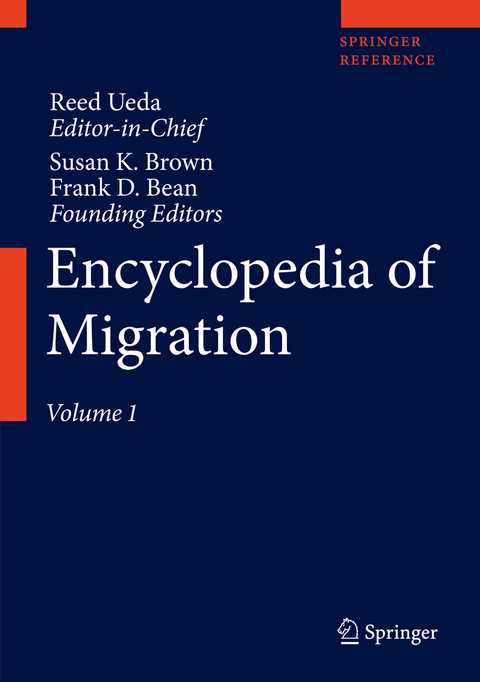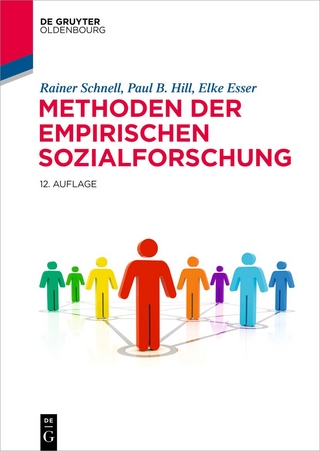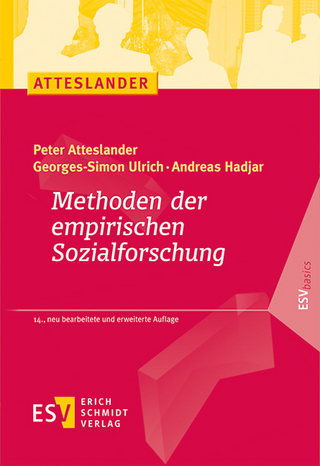
Encyclopedia of Migration
Springer (Verlag)
978-94-007-2785-4 (ISBN)
- Noch nicht erschienen (ca. Oktober 2026)
- Versandkostenfrei innerhalb Deutschlands
- Auch auf Rechnung
- Verfügbarkeit in der Filiale vor Ort prüfen
- Artikel merken
This International Encyclopedia of Migration will define and explicate terms, concepts and key topics with widespread usage and recurring relevance for learning about and developing the fields of both international and internal migration. With migration being partly defined in the modern era by law and public policy, the subject includes knowledge not only from these areas but also from a full array of academic disciplines. Hence, this encyclopedia will include material from such fields as anthropology, archaeology, criminology, demography, economics, education, ethnic studies, geography, health sciences, history, law, linguistics, public policy, political science, psychology and sociology. As migration has been such an important part of the peopling of all parts of the world, this encyclopedia will also include synopses of major geographic movements from ancient and early history.
The International Encyclopedia of Migration will be a significant resource for students, teachers, practitioners, scholars and researchers interested in or working on any aspect of migration in any field. It should be particularly useful for people seeking information and knowledge about migration from fields other than their own.
Dr. Ueda is a historian of the United States and of migration. He has explored global migration and its effects on societies and regions in Postwar Immigrant America (St. Martin's Press) and Crosscurrents: Atlantic and Pacific Migration in the Making of a Global America (Oxford University Press). He studied the role of local migrations in the rise of public education in Avenues to Adulthood (Cambridge University Press). Dr. Ueda was a research editor of the Harvard Encyclopedia of American Ethnic Groups (awarded the Waldo Leland Prize of the American Historical Association) and co-editor (with Mary C. Waters and Helen Marrow) of New Americans (Harvard University Press). He is also co-editor of the Journal of Interdisciplinary History (MIT Press). Dr. Ueda's research has been supported by fellowships from the Woodrow Wilson International Center, the National Endowment for the Humanities, the American Council of Learned Societies, and the Charles Warren Center at Harvard. A member of the Tufts History Department faculty since 1981, Dr. Ueda has been a visiting professor at Harvard University and Brandeis University. He is co-chair of a consortium, the Inter-University Committee on International Migration at the MIT Center for International Studies.Dr. Bean is a social scientist with 35 years of experience as a researcher, teacher, administrator and public policy analyst. His PhD is in sociology and his dissertation was written in social psychology. As a graduate student at Duke University, in addition to his work in sociology and social psychology (with Alan C. Kerckhoff, Kurt Back and Edward E. Jones), he took courses in demography and worked on research projects for three distinguished demographers (Reynolds Farley, Nathan Keyfitz and Hal Winsborough), all of whom subsequently became foundational leaders in population studies at prestigious universities in the United States (Michigan, Harvard and Wisconsin respectively). As the founding Director of both the Population Studies Center and the Immigration Policy Research Center at The Urban Institute in Washington, DC, Dr. Bean has also conducted work in and developed extensive knowledge about the economics of population and migration. He is currently Chancellor's Professor of Sociology and Economics at the University of California, Irvine. Dr. Brown is a tenured Associate Professor of Sociology at the University of California, Irvine. She is a sociologist/demographer whose areas of specialization are immigration, residential segregation and urban sociology. As a result of conducting research in these areas, she has also developed considerable expertise in geography and urban policy. In addition to her academic and research specializations, she also brings more than fifteen years of journalistic experience as a reporter and editor starting when she was on the staff of the Harvard Crimson and including nearly twelve years with the St. Louis-Post Dispatch.
TOPICS AND SUBTOPICS: (first draft)
Basic Outlines of Migration
Migration comprises a foundational unit of the study of any population. Measured in conjunction with births and deaths, migration into and out of any place determines the ultimate size of the population. Migration is a specialized form of moving that involves distinct components of distance, duration and residence. Conceptually, migration is often differentiated into internal and international flows. Internal migration historically has consisted in large part of continued urbanization of a previously rural population, but it may also show counterstreams moving from cities to suburbs.
International vs. internal
Distance and activity space, duration, and national versus local boundaries.
Change in circulation
Partial vs. total displacement migration
International as product of Westphalian system of nation-states
Growth of regulation in 20th century
Growth in typologies of migrants
Diasporas may exist without nation-state identification
Kinds of migration
Primitive, or nomadic
Voluntary, or agent-based, within large groups or clans or small-scale, as individuals or households
Authorized, legal, documented
Unauthorized, illegal, undocumented; "aliens"
Involuntary, or forced, impelled.
Displacement, warfare; environmental degradation and disaster
Human trafficking, slavery
Refugees, asylees
Circular, or returning migration, sojourner vs. settler
Step migration
Non-migration
International: students, tourists, business travelers; foreign-born vs. immigrants
Internal: Recurrent movement (commuting, daily crossings, seasonal work)
II. Measurement of Migration and Statistical Methodology
This topic covers the general demographic and statistical concepts underpinning migration research. Initially, migration research followed a standardized set of concepts and measurements derived from demographic research and often dependent upon the geographical units within which data are collected. However, the research has expanded into multiple fields with many methodologies, both qualitative and quantitative.
Demographic concepts
Flows vs. stocks
Areas of origin and destination
Emigration and immigration
Differential migration
Gross and net migration
Components of change (residual) estimation; forward survival.
Status and propensity rates, probabilities, in-migration, out-migration rates, net migration
Estimates and population projections
Distance, distance decay, gravity models
Efficiency: ratio of streams to counterstreams
Migration histories
Economic and sociological models
Econometric models and general models of inequality, within and between cities or countries
Multivariate regression analysis
Ethnographies
Spatial analysis
Geographic Information Systems, with database of attribute information, boundary files, digital map layers, analysis tools and user interface.
Political and data units: e.g. wards, counties, metropolitan areas, states, provinces, nations
III. Migration Data
Migration data vary widely across countries, both in terms of scope of collection and basic understanding of the definition of migration. This section examines the types of data collection instruments and their components.
Censuses
Frequency, coverage, de facto vs. de jure, usual residence, field checking, coverage error and content, net and differential undercounts, continuous measurement, migration questions, dual-system estimation, demographic analysis
Types of files and unit coverage: e.g. region, division, state, county, minor civil division/townships, places, census tracts, block groups, blocks.
Administrative records
Population registers, universal and partial; ports of entry and/or exit, passports and visas issued, immigration yearbooks, tax records, social welfare/security records, city directories, postal stops, school enrollments, construction permits, utility usage.
Surveys
Sampling issues, sample bias, panel studies, attrition.
Other sources
Naturalizations and change of migration status
Apprehensions and deportations; denaturalizations
Asylee petitions, United Nations High Commissioner for Refugees
IV. Migration Theories
No one theoretical perspective dominates the study of migration. Rather, multiple social science perspectives, all relatively new, compete with one another. This section will cover each theory and the underlying social, cultural and economic concepts.
Evolution of migration theories
Ravenstein’s laws
Intervening opportunities (Stouffer)
Intervening obstacles (Lee)
Demographic transition
Population pressure
"Push-pull"
Classical and neoclassical economics
Macro- and micro-theory
Regional labor supply and demand
Equilibrium wage markets
Opportunity costs
Marginal productivity of labor
Rational-actor and human capital models
Factor mobility
Discounted net returns over time
Expected earnings gap vs. absolute wage differential
New household economics
Credit and risk markets, insurance for crops, unemployment and retirement
Household-level decision making
Relative deprivation
Migration and intermediate investment
Labor-market segmentation
Structural inflation and status (occupational) hierarchies
Reference wages
Economic dualism and bifurcated labor markets; primary and secondary sectors
Ethnic enclaves and enclave economies
Demographic shifts in labor supply
World systems
Historical-structuralist view of uneven development; dependency theory
Core-periphery dichotomy
Brain drain
Land consolidation and agricultural displacement
Export-processing zones
Cultural linkages
Global cities and hourglass economy
Structuration; institutional theory
"Structure-agency problematic" (Giddens)
Intermediary institutions connect potential migrants to jobs
Social networks
Role of information
Chain migration, "auspices" of migration (Tilly and Brown)
Forms of fungible capital: social, human, financial, cultural
Enforceable trust
Strong and weak ties
Utility maximization
Cumulative causation
Social context of migration
Culture of migration
Social labeling of jobs
Migration hump, density function, cumulative density function
Political economy and state structure
Hegemonic stability in a geopolitical order<
Labor importation
V. Migrant Selectivity
Particular types of people are more likely to migrate than others. This section describes these typologies and the theoretical and practical considerations of migrants.
Adjustment causes vs. induced causes of residential mobility (Clark)
Adjustment: Housing/tenure, neighborhood effects, physical environment, public services, and accessibility, commuting
Induced: employment, job change, retirement
Induced: life cycle change
Household formation, change in marital status
Change in household size
Gender, age differentials
Place utility
Depends on stress threshold function for mobility decision
Stream of information
Residential preferences
Field theory approach to searching
Return migration
Duration-dependence
Socioeconomic mobility
Chronic movers
Seasonal dependence, snowbirds
Health of immigrants
Paradox of declining immigrant health in wealthier destination countries
Fertility changes
Reference group changes
VI. Urbanization
For more than a century, the dominant trend in worldwide migration has been urbanization, so that for the first time in history, more than half of the world’s population lives in an urban area. This section describes the aspects of urban growth related to migration.
Urban transition
Rural-urban continuum
Megalopolis/urban agglomeration
Transnational urban systems
Degree and pace of urbanization
Transportation, commuting costs; natural evolution theory
Fiscal, social stresses
Land conversion, water availability, infrastructure
Primate cities, megacities, global cities
Rank-size rule, balanced urban system
Density
Crowding, slums, squatters, gentrification
Central cities, suburbs, exurbs
Urban sprawl, multiple nuclei
NIMBY (Not In My Back Yard) movements
Theoretical perspectives of urbanization
Chicago School and human ecology, concentric zones, sector models; edge cities
Structural approach; uneven development (Harvey, Lefebvre); circuits of capital
Los Angeles school; post-Marxian, postmodernist epistemologies
Political economy and urban growth machines
Urban economics
Location theories (e.g. least-cost, economic base, incubator, industrial specializations and nodal metros; maquiladoras; export processing zones, employment poles)
Consumer functions, central place theory, retail gravitation
VII. Theories of Incorporation
This section describes the best-known theories of assimilation and incorporation.
Acculturation
Language acquisition, bi- or multilingualism, Fishman model of language acquisition
Customs, values and practices
Consonant and dissonant
Assimilation
Classical/canonical accounts: race relations cycle, structural assimilation, melting pot (triple melting pot), social distance, social networks, ethnic association, ethclass
Newer accounts: "Anglo-conformity," straight-line vs. bumpy line assimilation, neo-institutionalism, incorporation, immigrant generation.
Multiculturalism and pluralism
Ethnic construction and reconstruction, panethnicity
Boundary formation, bounded solidarity
Symbolic ethnicity; mosaic metaphor
Visible minorities
Ethnic Disadvantage
Ethnic hierarchy and structural disadvantage
Mainstream, "core" society
Segmented assimilation
Divergent paths
Downward mobility, oppositional subcultures, neighborhood effects
Selective acculturation, ethnic retention
Transnationalism
Globalization and transnational cultural studies
Transmigrants vs. diasporas
VIII. Kinds of Incorporation
Immigrants adjust to their destination society in multiple dimensions. This section expounds on the variety of responses to immigration by immigrants and the host society.
Identity formation
Public opinion toward immigration,
Negative: xenophobia, alien, prejudice, racism, self vs. Other, scapegoating
Positive: Model minority, "American Dream"
Multiracial identification; phenotype
Selective identification
Hyphenated identification
Socio-cultural incorporation
Religious and linguistic change
Ancestry studies
Second-generation revolt
Endogamy and exogamy rates
Economic incorporation
Opportunity structure: blocked mobility, hourglass economy
Ethnic economy
Educational opportunity: affirmative action
Spatial assimilation
Place stratification vs. spatial integration
Segregation mechanisms: steering, redlining, mortgage discrimination
Residential preferences
Home ownership and suburbanization
Political incorporation
Non-citizen: legalization, naturalization, civic association
Citizen: voting, political participation
<
Cultural citizenship
IX. Migration Policy
Policy strongly affects both internal and international migration. This section describes current and past policies across a range of countries. It includes legislation, legal cases, specific government offices and informal policy practices.
International migration
Entrance policies
Health and literacy tests
Quotas
Visa requirements, types of visas
Permanent vs. temporary visa types
Priorities for admittance, employment categories
Family reunification and sponsorship
Exit policies
Deportation and denaturalization
Criminalization of immigrants
Residence requirements
Incorporation policies, job banks and civics and language training
Citizenship
Jus soli vs. jus sanguinis
Dual citizenship
Guest workers
Specific flows, e.g. Gastarbeiter, braceros
Repatriation
Restrictions on employment
Control of immigration
Border policies
Bureaucracies
Migrants’ rights
Civil protections
Secondary and tertiary education; tuition
Access to jobs
Internal migration
Home ownership, mortgage interest tax deductions, lending practices, housing institutions
Transportation: commuting, highway systems and public transportation
Job training, job transfers and tax policy
Residency requirements (e.g. hukou in China) and floating populations
X. Global Institutions
A large body of literature covers the global economic and political institutions that enable transfer of capital, investment, and the movement of people. This section covers some of the institutional actors and treaties that have enabled global movement of goods and people, from the Pax Romana to the Peace of Westphalia to the United Nations, the International Monetary Fund and the General Agreement on Tariffs and Trade.
XI. Fiscal and Economic Aspects of Migration
This section explores the effects of immigration on receiving and sending countries, to the economy as a whole and as a net fiscal burden at the national and regional levels.
Remittances
Multiplier (second round) effects
Short-run income effects (income elasticities) and income distribution
Consumption vs. investment uses
Repatriation of foreign earnings
Community development
Economic effects
Returns to scale
Wages of natives
Productivity of labor and capital
Revenues and expenditures
Welfare expenditures
Tax streams
XII. Major Migration Streams
A comprehensive account of migration will include the major migrations of both historical and contemporary times. These will include international settlements and internal displacements.
Receiving Countries
Colonization: USA, Canada, Australia, New Zealand, Siberia, South Africa, Israel, Latin America
Contemporary labor importation: Europe, Japan, Middle East, Africa (refugees)
Sending countries
Traditional: Europe, China, India, Philippines
Contemporary: East Asia, South Asia, Africa, Latin America, Caribbean
Prehistoric migrations
Homo erectus, Neanderthals, Cro-Magnon
Paleo-Indian
Indo-European
Aboriginal seafarers
Early historical migration
Mediterranean (e.g. Phoenician, Greek, Roman)
Celtic
Bantu
Lapita in New Guinea
Turk and Mongol, steppe peoples
Huns and those they displaced: Goths and Vandals
Anglo-Saxon
Arab
Viking in western Europe and Russia
Norman
Germans eastward
Toltec and Aztec
African slaves
Historical diasporas:
Jews
Roma
Italians and other Europeans
Chinese
Armenians
XIII. Other
| Erscheint lt. Verlag | 26.10.2026 |
|---|---|
| Reihe/Serie | Encyclopedia of Migration | 1.10 |
| Zusatzinfo | 2000 p. In 2 volumes, not available separately. |
| Verlagsort | Dordrecht |
| Sprache | englisch |
| Maße | 178 x 254 mm |
| Themenwelt | Schulbuch / Wörterbuch ► Lexikon / Chroniken |
| Sozialwissenschaften ► Soziologie ► Empirische Sozialforschung | |
| Sozialwissenschaften ► Soziologie ► Spezielle Soziologien | |
| Wirtschaft ► Volkswirtschaftslehre ► Wirtschaftspolitik | |
| Schlagworte | assylum • economic migration • Emigration • encyclopaedia • Ethnicity • Human Trafficking • Immigration • Integration • internal migration • International migration • Labour Migration • Migration • migration data • Migration Policy • migration streams • migration theories • Refugees • Social Sciences • urbanization |
| ISBN-10 | 94-007-2785-2 / 9400727852 |
| ISBN-13 | 978-94-007-2785-4 / 9789400727854 |
| Zustand | Neuware |
| Haben Sie eine Frage zum Produkt? |
aus dem Bereich


